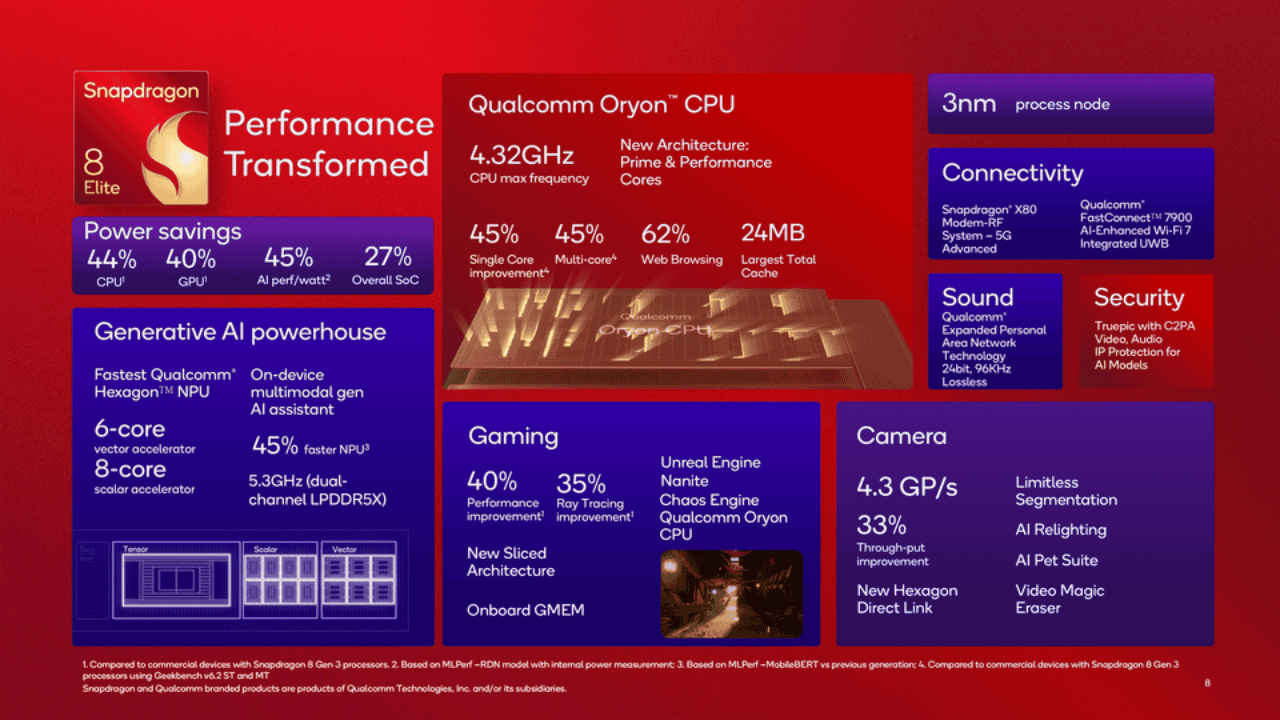Snapdragon 8 Elite: Qualcomm’s new powerhouse AI mobile chip decoded

In the ever-evolving landscape of mobile technology, the race for superior performance and efficiency is relentless. Qualcomm has just thrown down the gauntlet with the unveiling of its latest flagship chipset, the Snapdragon 8 Elite. Poised to power the crème de la crème of Android smartphones from late 2024 through most of 2025, this chip represents significant gains in mobile processing, artificial intelligence, GenAI, gaming, and connectivity.
 Survey
SurveyAs we delve into what makes the Snapdragon 8 Elite a game-changer, it’s clear that Qualcomm isn’t just aiming to keep pace with the competition – they’re intent on redefining the boundaries of what’s possible in mobile computing. So let’s see what all the fuss is about, shall we?
It’s all about the Qualcomm Oryon CPU
At the core of the Snapdragon 8 Elite lies the brand-new, second-generation Qualcomm Oryon CPU. This isn’t just an incremental upgrade, according to Qualcomm – it’s a complete architectural overhaul designed from the ground up to deliver unprecedented power and efficiency. Clocking in at a staggering peak speed of 4.32 GHz, Qualcomm touts it as the fastest mobile CPU in the world.
But raw speed is just part of the story. The Oryon CPU boasts a 45% boost in performance over its predecessor, while also achieving a 44% improvement in power efficiency. This means users can expect lightning-fast multitasking, smoother browsing, and seamless transitions between apps — all without draining the battery, which is very important from any user’s perspective. In fact, the chip delivers up to 27% in overall power savings, potentially extending gaming sessions by up to 2.5 hours, according to Qualcomm.

A significant contributor to this performance leap is the industry’s largest shared cache in a mobile processor. With a massive 24MB of L2 cache — split evenly between performance and efficiency cores — the CPU can access data more quickly, reducing latency and enhancing overall responsiveness.
(Gen)AI at your mobile fingertips
Artificial intelligence is no longer a buzzword confined to tech conferences – it’s an integral part of our daily mobile experiences. The Snapdragon 8 Elite takes AI capabilities to seemingly new heights with its enhanced Qualcomm AI Engine. The engine supports multimodal generative AI, enabling the device to understand and process voice, text, images, and even contextual data from the camera. This is a significant development, if you think about it.
Imagine pointing your camera at a complex scene and having your device not only recognise individual elements but also provide actionable insights or suggestions. Whether it’s identifying landmarks, translating text in real-time, or offering shopping links for items in view, the possibilities are expansive.
The AI Engine is powered by various models, including large multimodal models (LMMs), large language models (LLMs), and large vision models (LVMs). With support for longer token inputs, users can feed entire book chapters or lengthy documents into their device, transforming it into a pocket-sized expert on any subject.
Underpinning these capabilities is the upgraded Hexagon Neural Processing Unit (NPU), which is now 45% faster and offers 45% improved performance per watt, according to Qualcomm. This ensures that AI tasks are executed swiftly and efficiently, without compromising battery life.
Mobile gaming upgraded
For gamers, the Snapdragon 8 Elite is nothing short of a revelation. The chipset introduces the first-ever Adreno GPU with a sliced architecture — a design that allocates dedicated memory and processing power to each slice, enhancing performance and efficiency.

Qualcomm claims a remarkable 40% improvement in GPU performance and a 40% increase in power efficiency compared to the previous generation. This leap enables mobile devices to deliver console-quality graphics, rendering stunning, film-like environments that were once the sole domain of high-end gaming rigs.
The GPU’s support for Unreal Engine 5.3 with Nanite technology means developers can create intricate 3D environments with millions of polygons, all rendered in real time on a mobile device. Combined with optimised performance for the Unreal Chaos Physics Engine, gamers can expect hyper-realistic simulations — from lifelike water flows to destructible environments that react authentically to player actions.
Moreover, the Oryon CPU ensures ultra-responsive gameplay, minimising latency and providing a smooth, immersive experience. With these advancements, mobile gaming is poised to enter a new era, blurring the lines between smartphones and dedicated gaming consoles.
AI-powered camera for smartphone photography
Photography enthusiasts will find much to celebrate with the Snapdragon 8 Elite’s camera capabilities. The chipset features an AI-integrated Image Signal Processor (ISP) that works in tandem with the Hexagon NPU to enhance every shot.

One of the standout features is the AI-powered Limitless Segmentation technology. This innovation can recognize and optimise over 250 layers within an image in real time. Whether it’s adjusting the lighting on a subject’s face, enhancing the colour of the sky, or sharpening details on distant objects, the technology ensures each element of the photo is captured in its best light. Computational photography enthusiasts are guaranteed to flip out!
For pet owners, the AI-based Pet Capture feature intelligently tracks and focuses on animals, ensuring that even the most energetic pets are captured with clarity. Additionally, the Video Object Eraser allows users to remove unwanted elements from video footage directly on the device — a tool that was once the purview of desktop editing software.
The camera system supports 4K video capture at 60 frames per second, even in low-light conditions, thanks to advanced noise reduction and image enhancement algorithms. With these capabilities, Qualcomm suggests users can produce professional-quality photos and videos without the need for external equipment.
Studio-grade audio with enhanced connectivity
Audio quality is often an overlooked aspect of the mobile experience, but the Snapdragon 8 Elite places it front and centre. With the Snapdragon Sound Technology Suite, Qualcomm claims users can enjoy lossless music streaming, ensuring every beat and note is reproduced true to source.
The inclusion of Qualcomm’s Expanded Personal Area Network (XPAN) technology extends the range and bandwidth of wireless audio connections. This means you can move freely throughout a building without losing connection to your earbuds — a significant improvement over traditional Bluetooth limitations. For gamers and movie enthusiasts, lag-free spatial audio adds a new dimension to the experience, immersing the listener in a 3D soundscape that enhances engagement and enjoyment.
On the connectivity front, the Snapdragon 8 Elite is the first platform to integrate Wi-Fi, Bluetooth, and Ultra-Wideband (UWB) technologies. This integration enables hyper-accurate proximity sensing, allowing users to locate lost items, access secure buildings, or interact with smart home devices seamlessly.
The chipset features the Snapdragon X80 5G Modem-RF System combined with the Qualcomm 5G AI Suite Gen 3, which Qualcomm claims delivers superior 5G performance and multi-gigabit speeds. The Qualcomm FastConnect 7900 Mobile Connectivity System provides support for Wi-Fi 7, offering blazing-fast wireless connections and up to 40% power savings.
Snapdragon 8 Elite vs Competition
Early benchmarks and industry reports suggest that the Snapdragon 8 Elite doesn’t just outperform its Android predecessors — it gives Apple’s latest A18 Pro chip on the iPhone 16 Pro series a serious run for its money. This is particularly significant in an industry where Apple’s silicon has long been considered the gold standard for mobile performance.
Manufactured on TSMC’s advanced 3-nm process node, the Snapdragon 8 Elite benefits from increased transistor density, which translates to higher performance and improved energy efficiency. The use of Qualcomm’s self-designed Oryon cores marks a strategic shift, allowing the company to optimise the CPU architecture specifically for its target use cases.
Also Read: Elon Musk should focus more on SpaceX for his true legacy: Here’s why
The Adreno 830 GPU, with its tri-slice architecture running at 1.10 GHz, supports modern graphics APIs and advanced features like real-time ray tracing. Qualcomm claims a 35% improvement in ray tracing acceleration, enabling more realistic lighting and shadow effects in games and applications.
Memory support has also been enhanced, with the chipset accommodating dual-channel LPDDR5X RAM running at 5.30 GHz. This ensures that the processor isn’t bottlenecked by slower memory speeds, maintaining smooth performance even under heavy multitasking or gaming loads.
The Snapdragon 8 Elite is set to power a wave of flagship Android smartphones from leading manufacturers like Samsung, Xiaomi, and OnePlus. Devices featuring this chipset are expected to hit the market between October and December 2024, with the Samsung Galaxy S25 series among the anticipated launches.
For consumers, this means a new generation of smartphones that not only push the envelope in terms of raw performance but also offer enhanced AI capabilities, superior gaming experiences, and advanced camera functionalities.
Qualcomm’s emphasis on AI integration across all aspects of the chipset — from the CPU and GPU to the ISP and connectivity modules — signals a shift toward more intelligent, context-aware devices. As AI models become more sophisticated, on-device processing will be crucial for privacy, efficiency, and responsiveness.
As we move into 2025, the impact of the Snapdragon 8 Elite will be felt across the Android ecosystem. It raises the bar for competitors and promises consumers devices that are not just smarter and faster but also more attuned to their needs and lifestyles. For those contemplating their next smartphone upgrade, the arrival of Snapdragon 8 Elite-powered devices is an exciting development worth keeping an eye on.
Jayesh Shinde
Executive Editor at Digit. Technology journalist since Jan 2008, with stints at Indiatimes.com and PCWorld.in. Enthusiastic dad, reluctant traveler, weekend gamer, LOTR nerd, pseudo bon vivant. View Full Profile